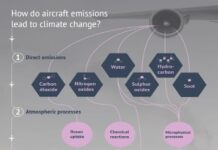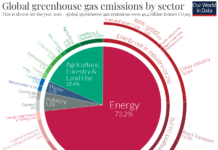Climate change is defined as the changes in the long-term averages of daily weather, over time and geographic spac
Earth’s climate has changed throughout history. In the last 650,000 years there have been seven cycles of glacial advance and retreat, with the abrupt end of the last ice age about 11,700 years ago. This abrupt ending of the last ice age marked the beginning of the modern climate era — and of human civilization.
Most climate changes are attributed to very small variations in Earth’s orbit that change the amount of solar energy our planet receives. However, the current warming trend is of particular significance.
The scientific consensus is that climate change is (greater than 95% probability) a result of human activity since the mid-20th century, and proceeding at a rate that is unprecedented over decades to millennia.[1]IPCC Fifth Assessment Report, Summary for Policymakers B.D. Santer et.al., “A search for human influences on the thermal structure of the atmosphere,” Nature vol 382, 4 July 1996, 39-46; Gabriele … Continue reading
According to the Intergovernmental Panel on Climate Change (IPCC) the scientific evidence for warming of the global climate system is unequivocal. Global warming has already had observable effects on the environment.
Further, the effects that scientists had predicted as a result of global climate change are occurring at a faster and faster rate e.g. loss of sea ice, accelerated sea level rise, longer, more intense heat waves, shrinking glaciers, ice on rivers and lakes is breaking up earlier, plant and animal ranges shifting, and trees are flowering sooner.
Scientists, unfortunately, also have high confidence that global temperatures will continue to rise for decades to come due to the continuing increase in greenhouse gases produced by human activities.
THE GREENHOUSE EFFECT
The Greenhouse Effect, Phys.Org
The ‘greenhouse effect’ is the warming of the climate that results when the atmosphere traps heat radiating from Earth toward space. Certain gases in the atmosphere resemble glass in a greenhouse. These gases allow sunlight to pass into the ‘greenhouse,’ but block Earth’s heat from escaping into space. The gases that contribute to the greenhouse effect include water vapor, carbon dioxide (CO2), methane, nitrous oxides, and chlorofluorocarbons (CFCs).
Earth’s natural greenhouse effect is critical to supporting life. Without the greenhouse effect the average temperature on Earth would be about -18 °C instead of the current of about 15 °C . [2] “Annex III Glossary” (PDF). Intergovernmental Panel on Climate Change. Retrieved 10 October 2019.
Human activities, mainly the burning of fossil fuels and clearcutting of forests, have increased the greenhouse effect and caused global warming.[3] IPCC AR4 WG1 (2007), Solomon, S.; Qin, D.; Manning, M.; Chen, Z.; Marquis, M.; Averyt, K.B.; Tignor, M.; Miller, H.L. (eds.), Climate Change 2007: The Physical Science Basis, Contribution of … Continue reading The Intergovernmental Panel on Climate Change in its most recent assessment report (AR5) [4] IPCC, 2014: Climate Change 2014: Synthesis Report. Contribution of Working Groups I, II and III to the Fifth Assessment Report of the Intergovernmental Panel on Climate Change [Core Writing … Continue reading states that:
- “Anthropogenic (human caused) increases in greenhouse gas emissions, driven largely by economic and population growth, are the main driver of this warming. Carbon dioxide, methane and nitrous oxide levels in the atmosphere are increasing at an unprecedented rate, when compared to the past 800,000 years.
Climate scientists agree that human activity is the main driver behind the global warming we are experiencing.
References
| ↑1 | IPCC Fifth Assessment Report, Summary for Policymakers B.D. Santer et.al., “A search for human influences on the thermal structure of the atmosphere,” Nature vol 382, 4 July 1996, 39-46; Gabriele C. Hegerl, “Detecting Greenhouse-Gas-Induced Climate Change with an Optimal Fingerprint Method,” Journal of Climate, v. 9, October 1996, 2281-2306; V. Ramaswamy et.al., “Anthropogenic and Natural Influences in the Evolution of Lower Stratospheric Cooling,” Science 311 (24 February 2006), 1138-1141; B.D. Santer et.al., “Contributions of Anthropogenic and Natural Forcing to Recent Tropopause Height Changes,” Science vol. 301 (25 July 2003), 479-483. |
|---|---|
| ↑2 | “Annex III Glossary” (PDF). Intergovernmental Panel on Climate Change. Retrieved 10 October 2019. |
| ↑3 | IPCC AR4 WG1 (2007), Solomon, S.; Qin, D.; Manning, M.; Chen, Z.; Marquis, M.; Averyt, K.B.; Tignor, M.; Miller, H.L. (eds.), Climate Change 2007: The Physical Science Basis, Contribution of Working Group I to the Fourth Assessment Report of the Intergovernmental Panel on Climate Change, Cambridge University Press, ISBN 978-0-521-88009-1 (pb: 978-0-521-70596-7) |
| ↑4 | IPCC, 2014: Climate Change 2014: Synthesis Report. Contribution of Working Groups I, II and III to the Fifth Assessment Report of the Intergovernmental Panel on Climate Change [Core Writing Team, R.K. Pachauri and L.A. Meyer (eds.)]. IPCC, Geneva, Switzerland, 151. |








